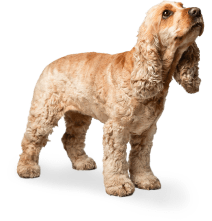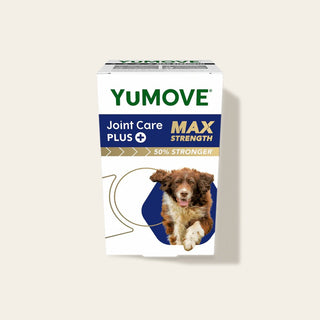

Does cold weather affect your dog’s joints?
As your dog gets older, they may be more prone to experiencing occasional joint stiffness and could benefit from a little extra care to help them continue living their best life.
While proper exercise, good nutrition and the right routine can play a key role in supporting your dog’s mobility, it’s also important to consider environmental factors. For example, colder weather can make existing stiffness feel more noticeable, so being especially attentive to your dog’s comfort during the chillier months can really help.
Read on to discover how the cold weather can affect your dog’s joints, and tips to keep your pup happy, healthy and active all winter long…
Why cold weather affects your dog’s joints
Animal experts aren’t entirely sure why colder weather seems to affect dogs’ joints, but here are a few possible reasons:
- A drop in air pressure – This can cause tissues in your dog’s body to swell, making movement feel a little more challenging.
- Tense muscles – In cold weather, dogs often tense their muscles to stay warm. While this helps conserve heat, it can make their muscles less flexible and lead to a stiff, awkward gait, making movement harder.
- Less exercise – Freezing temperatures often mean shorter walks, more time indoors and less movement overall. However, gentle activity is important for dogs with occasional joint stiffness, as it helps keep their muscles moving and their joints supported.
Exercising your dog when it’s cold
Keeping your dog moving is key to supporting their joint health and mobility throughout their life. Moderate movement helps keep their joints active, stretches and strengthens muscles, and keeps them engaged in daily life.
Dogs also thrive on a steady routine. If your dog was active during the warmer summer months, a drop in activity when it’s cold could affect their mood. Try to go on at least one walk a day, ideally at midday when it’s warmer, rather than in the morning or evening. You can also work with your vet to create a tailored exercise plan.

If the weather is too harsh – think snow, strong winds or freezing temperatures – encourage your dog to play and move indoors. Alternatively, consider booking a dog hydrotherapy class if one is available in your area. Swimming is an excellent form of exercise for dogs with occasional stiffness, as the water supports their body, reduces pressure on their joints and allows them to move more comfortably. Plus, it helps strengthen muscles, stimulates blood flow and can support range of motion.
Not sure if your local pool offers canine sessions? Speak to your vet. Canine hydrotherapy requires veterinary approval, so your vet is likely to know if classes are available nearby.
Other ways to battle the cold
During the winter months, you might notice that your senior dog seems stiffer than usual – especially first thing in the morning on those chilly, frosty days. Take a look at our handy guide for some tips on how to create a winter-specific plan for your pup. Or, keep reading to discover some of the best things you can do to battle the cold and support your dog’s mobility.
1. Get cosy

Cold temperatures can make movement a little harder for your dog, so it’s important to keep them warm and comfortable. Add extra blankets to their bed so they can snuggle up, and consider a raised bed to keep out drafts. Pet-safe heating pads and cosy accessories can also help keep them toasty during the colder months while they dream the night away. Placing their padded bed in a warm, quiet spot will give them a snug space to rest and recharge, helping them stay cosy and comfortable.
Clothing – such as waterproof jackets and coats – can also help to keep the joints warm. Smaller breeds, senior dogs and those with thinner coats may need a little extra warmth during winter walkies. If you find that your dog’s extra chilly after a walk, make sure to warm them up when you get home.
2. Let them rest

Your dog may not feel like doing as much exercise if the cold weather is making their joints feel stiffer, so it’s important to give them plenty of time to rest.
In winter, a comfortable, supportive bed is especially important to support your dog's joints. Look for an ergonomic bed designed to support their joints, and make sure it’s big enough for them to stretch out fully. If your dog likes to move around during the day, placing a couple of beds in different spots around the house can be helpful.
If your dog enjoys snuggling on the sofa or your bed, try lifting them up instead of letting them jump or climb. A dog ramp or stairs can be a great solution to help them reach their favourite spots more easily and comfortably.
3. Keep them trim

During the colder months – especially around the festive season – both people and their pets tend to move less and indulge a little more. But did you know that overweight dogs are more likely to experience joint stiffness? Along with the added weight on their joints with every step, excess fat can also contribute to inflammation.
If you’re unsure how to help your dog maintain a healthy weight this winter, your vet is a great resource and will be happy to offer advice.
5. Try a supplement
If your dog isn’t already taking joint supplements, winter might be the perfect time to start. Our YuMOVE range for dog joints is specially designed to help maintain their mobility, support overall joint health, and soothe stiffness.
YuMOVE helps your dog’s joints
If your dog isn’t already taking joint supplements, winter might be the perfect time to start. Adding a high-quality joint supplement to your dog’s routine is a great way to help support their joint health, whatever the season. Our YuMOVE Dog Joint Care range includes scientifically backed ingredients to help soothe joints, support joint structure and aid mobility. Our unique ActivEase® Green Lipped Mussel, sustainably sourced from the clear waters of New Zealand, provides Omega-3 fatty acids to help soothe occasionally stiff joints.
Our supplements can help your dog live their most active life, for life. See a difference in just 6 weeks, or your money back, guaranteed.*
YuMOVE Joint Care PLUS Max Strength is our strongest PLUS formula yet – delivering 50% more strength* for dogs with occasionally stiffer joints who may need extra support. Subscribe today and get 50% off* your first two months.




